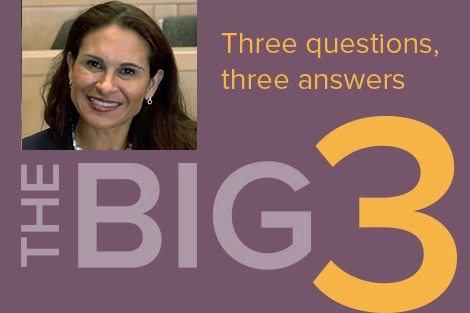October 31, 2019 – Francesca Dominici, professor of biostatistics at Harvard T.H. Chan School of Public Health and co-director of the Harvard Data Science Initiative, and colleagues have studied the growing threat posed by wildfires in the western U.S., estimating both their future prevalence and their potential health impacts.
Q: Massive wildfires are spreading across California, along with huge amounts of smoke. What is in the smoke that makes it dangerous to breathe, and what are the major health harms that can result from overexposure?
A: Wildfire smoke leads to very high levels of fine particulate air pollution, known as PM2.5. Many studies have shown that short- and long-term exposure to this type of pollution, even at levels well below the ones produced by wildfires, are very harmful.
Smoke from wildfires is a complex mixture of carbon dioxide, water vapor, carbon monoxide, particles, hydrocarbons and other organic chemicals, nitrogen oxides, and trace minerals. Cellphones, computers, refrigerators, and cars are just some of the objects that have been vaporized in California’s deadly wildfires, and the chemicals and particles from the melted objects have blanketed large sections of the state.
In a 2017 study, we estimated daily PM2.5 concentrations directly attributable to wildfires for the entire western United States for 2004-2009. We looked at possible health impacts when there’s a “smoke wave”—a term we coined that refers to two or more consecutive days with unhealthy PM2.5 levels. We found that, among people over age 65, hospital admissions for respiratory problems were 7.2% higher during smoke-wave days than on non-smoke-wave days.
Q: If you’re exposed to wildfire smoke, what can you do to minimize health harms?
A: You can do things like limit your physical activity, stay inside with the doors and windows closed, and reduce sources of indoor air pollution such as cigarette smoke and wood-burning stoves. Other ways to decrease indoor air pollution are to avoid using aerosol products or frying or broiling meat.
On days that are hot and smoky, people without air conditioning may want to go somewhere with good HVAC systems, like public libraries, hospitals, or movie theaters, or to a clean air shelter if their community has one.
There are many more helpful recommendations on the AirNow.gov website.
Q: In 2016 you co-authored a study that predicted that, between 2046 and 2051, more than 82 million people will likely be affected by smoke waves in the western U.S. Can you discuss these findings, and offer thoughts on what measures can be taken to prevent smoke-related health harms on a large scale?
A: Our study demonstrated that smoke waves from wildfires are likely to be longer, more intense, and more frequent under climate change. We found that, as the climate warms, creating drier conditions that are the precursor to wildfires, millions more will be at risk for dangerous health impacts.
We used a fire prediction model and advanced atmospheric modeling to separate out pollution caused by wildfires and track the likely movement of smoke. We studied 561 counties across the western U.S. and estimated that 312 will experience more intense smoke waves in the next 30 years. Our estimates of future PM2.5 levels from wildfires were based on a scenario assuming moderately increasing greenhouse gases by mid-century.
First we looked at data from 2004-2009 and found that about 57 million people in the western U.S. experienced a smoke wave during that time. Then we estimated that, between 2046 and 2051, more than 82 million people will experience a 57% and 31% increase, respectively, in the frequency and intensity of smoke waves—mostly in northern California, western Oregon, and the Great Plains, where fire fuel is plentiful. We also estimated that about 13 million more children and seniors, who are at higher risk for respiratory illness, will be affected by smoke waves compared with the present day.
Our findings suggest the need to establish or modify U.S. wildfire management and evacuation programs in high-risk regions, and to think about the needs of vulnerable subpopulations when preparing for wildfire disasters. And, in the bigger picture, it is becoming increasingly urgent that the government listen to scientists and implement the most effective strategies to combat climate change.
